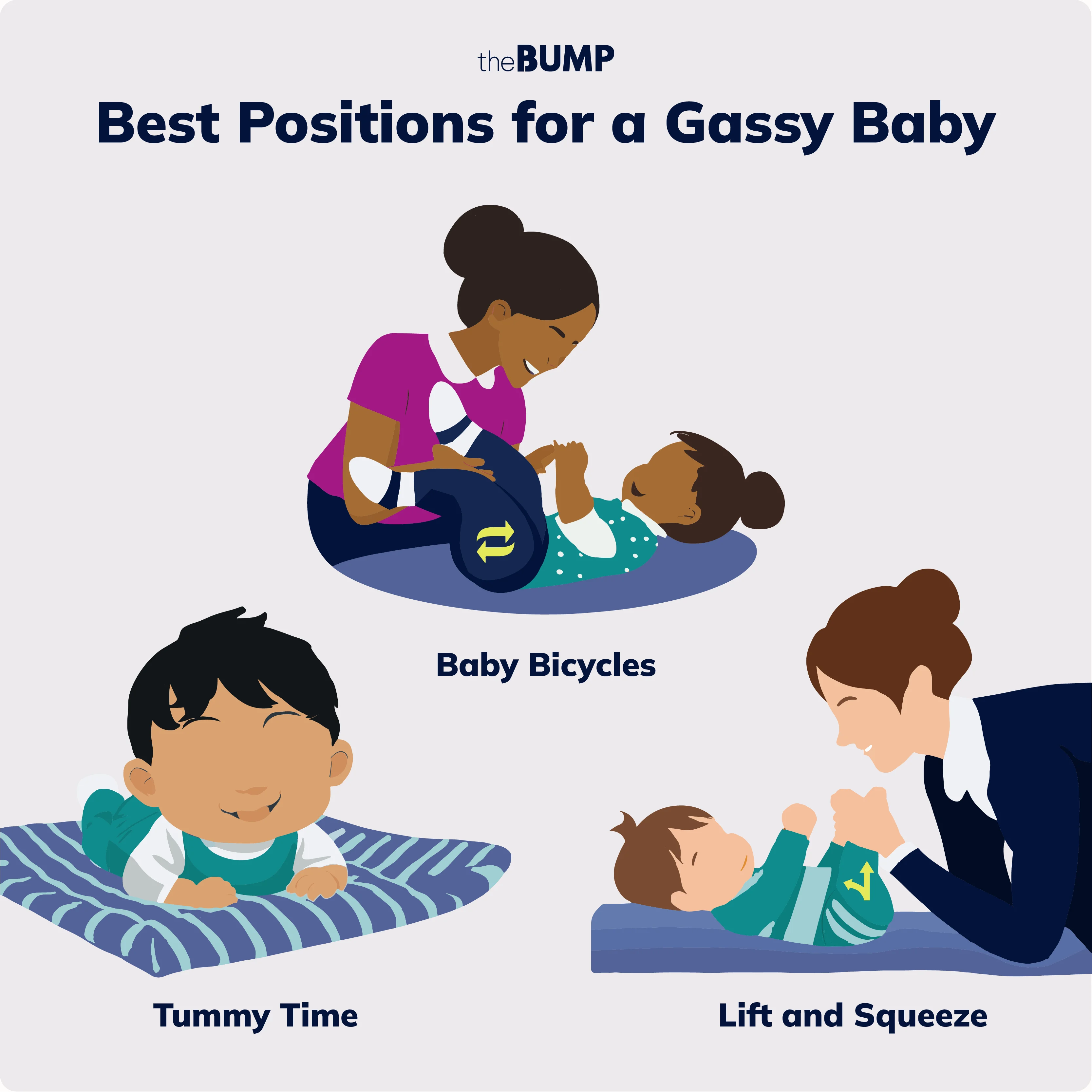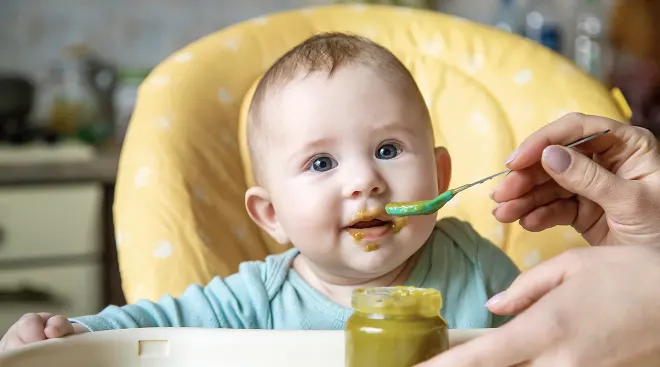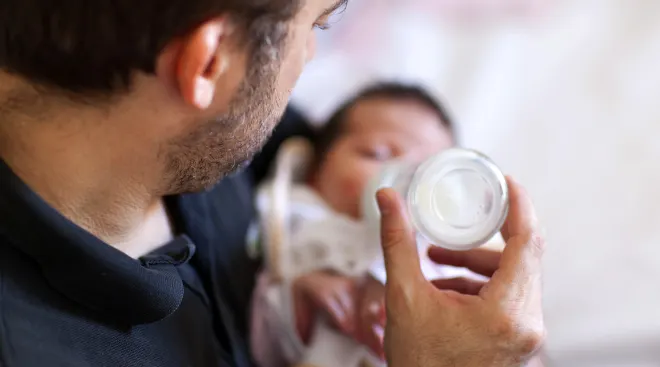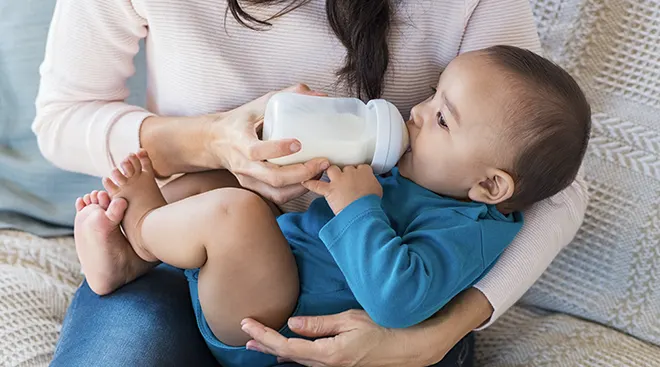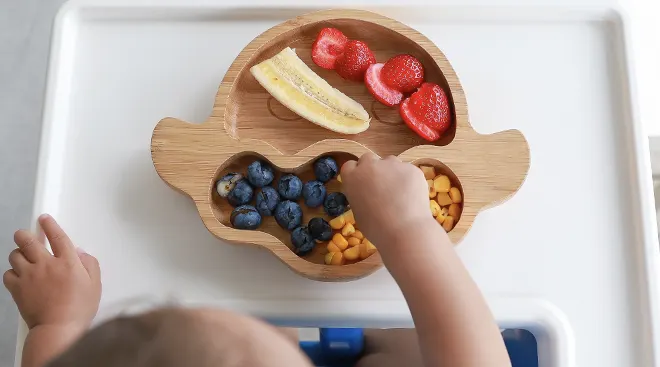What to Do for a Gassy Baby
Everyone knows what gas pain feels like—it’s that uncomfortable, cramping feeling you get when a gas bubble is trying to work its way out of your digestive system. It can be painful for anyone, so it’s no wonder it’s often touted as a culprit when baby’s fussy and squirmy. However, while common, it can be hard to differentiate baby gas from something else. Here’s how to figure out if you’re dealing with a gassy baby, or if something else is at play—plus tips to help get baby gas relief, straight from pediatricians.
Got a gassy baby on your hands? Unfortunately, it’s a normal part of baby’s development as they learn to get their food and nutrients from milk or formula outside of the womb. “Infants need time for the GI systems to mature. As their [bodies] become used to a feeding routine, gas can be caused by numerous different reasons,” says Sarah Keathley, MS, RD, LD, a certified registered dietitian nutritionist with over 12 years of experience working with children.
Gas and related issues can start beginning when baby is a few weeks old all the way up through the toddler stage. That said, Katherine O’Connor, MD, attending pediatric hospitalist at Children’s Hospital at Montefiore in New York City, says that baby gas tends to be the worst between 4 to 12 weeks, typically peaking around the time baby is 8 weeks old. “They tend to have a lot of trouble with digestion,” she says.
It can be hard to know if baby gas is the cause of your child’s discomfort, especially when they can’t tell you what’s going on. But, according to experts, there are a few common signs of a gassy baby you can look for, including:
- Red-faced
- Crying
- Fussiness
- Squirming post-feeding
- Increased spit-up
- Decreased appetite
- Clenched fists
- Pulling legs up toward their tummy
- Grunting noises
- Stomach noises (like gurgling and bubbling sounds)
- Tight, swollen or bloated belly
- Passing gas
The way to know for sure that infant gas is to blame? Actual burps or farts. “If you get a few burps out of baby or do something else to move things along, most babies are relieved of the symptoms and will stop crying,” O’Connor says.
Yes, gas is developmentally normal as baby learns to feed and their digestive system develops, but are there things that can exacerbate gas in babies? “Generally, when baby is suffering from gas, the stomach is inflated with air, which has either occurred from the digestion process or because baby has swallowed a lot of air while feeding,” O’Connor says. Here, the experts break down some common reasons for a gassy baby:
- The development of baby’s intestines: According to Jessica Madden, MD, IBCLC, a board-certified pediatrician and medical director of Aeroflow Breastpumps, “the normal colonization of babies’ intestines with bacteria (called the microflora)” can produce gas, leading to a gassy baby.
- Drinking too quickly: If the nipple on baby’s bottle has too fast of a flow, or if a breastfeeding mom has an overactive supply, baby will end up swallowing air with the milk, which can cause gas, Madden explains.
- Drinking too slowly: Similarly, if the nipple on baby’s bottle has too slow of a flow, baby may suck in extra air while drinking milk, also leading to gas pain.
- Drinking formula with air bubbles: If you’re mixing powdered milk for baby, make sure to let it sit and settle for a couple minutes before feeding. The more you shake the formula, the more air bubbles enter the milk, which can lead to a gassy baby, says Meredith Grossman, MD, assistant professor of pediatrics at the Icahn School of Medicine at Mount Sinai in New York City.
- Not tolerating a formula well: Infant formulas are made differently, so what works well for one child may not work well for another. Gas could be a sign that baby isn’t tolerating their current formula well, Grossman says. That said, sometimes parents switch formulas too readily, as a 2022 study found that many American infants are on hypoallergenic formulas even when it’s not medically necessary. Before making any changes to baby’s diet, make sure to talk to your pediatrician first.
- Ingesting gas-inducing foods. Infant gas can also happen naturally as food is broken down during the digestive process. It’s even more likely to occur if baby has a food intolerance to something they’ve eaten, or something mom’s eaten that makes its way into the breast milk.
- Crying for extended periods: Baby can also become gassy if they swallow air while crying for an extended period of time, Madden notes—which is why calming baby quickly is important. “We often think that crying is a sign that babies are suffering from gas, but instead, it’s often a cause of gas,” Keathley adds. Basically, it’s a vicious cycle.
There may also be some other conditions that can create a gassy baby. “When baby keeps crying despite passing gas, you know that there’s something else going on,” O’Connor says.
- Reflux: If your little one has reflux—when stomach contents back up into the esophagus and out of the mouth—they may struggle and arch their back, rather than curl in. It’s important to be able to differentiate the two, as reflux can be worsened by burping. “It usually happens about half an hour after feeding, and you won’t see the same kind of relief from burping or passing gas,” O’Connor says. Rather, the burp can bring up reflux that further irritates baby. You’ll see obvious spit up, arching of the body or discomfort after feeding.
- Infant dyschezia: Even if baby seems like they’re struggling to poop, it may just be what doctors call infant dyschezia. “This is when babies grunt and strain a lot while making bowel movements due to discoordination and underdevelopment of the muscles in the intestines and pelvis,” Madden says. These episodes can include a lot of flatulence (some of which may be smelly!), last between 10 to 30 minutes and lead to baby passing soft, normal stools.
- Constipation: Constipation is rare in newborns and younger babies. As Keathley notes, “it’s normal for an infant to stretch their time between stools, especially after their first 6 to 8 weeks of life.” Plus, as mentioned, a fair amount of straining is usually normal for babies. There’s no need for concern if baby’s tummy is soft and they seem to be content and alert. However, if their stool comes out in hard pellets, it’s likely they’re constipated.
Differentiating between a gassy newborn and colic
Babies who cry a lot—as in several hours a day—are often said to have gas pain. But is it really gas? O’Connor says often a more accurate term for the problem is colic, which is when baby cries for more than three hours straight for at least three days a week. Colic can start as early as 2 to 3 weeks old, Madden says. Some experts think colic might be related to babies’ underdeveloped digestive or nervous systems, which can cause general, extended discomfort with no easy cure. Newborn gas and colic can appear to have similar symptoms: In addition to the crying, colicky babies often curl their legs toward their abdomen. Colic may or may not be related to belly pain, but some experts think colicky babies only appear gassy because they swallow so much air while crying due to existing colic pain. “If the parent has tried everything else they can do—feeding, burping, changing, rocking, all of it—and baby is still crying, then it’s likely colic,” O’Connor says.
Watching a gassy baby struggle in pain can break any parent’s heart, and you might wonder how to get rid of baby gas fast. Fortunately, there are several infant gas relief options to help baby release the gas and soothe their discomfort. Read on to learn how to relieve gas in babies.
- Change baby’s bottle: If you bottle-feed baby, “use bottles that help to prevent gas, which are usually vented or have other features that prevent the baby from swallowing a lot of air,” Grossman suggests. Plus, as you’re giving baby the bottle, tilt it to let as little air into the nipple as possible. Or, you can also try changing the bottle nipple. “A slower flow bottle nipple may help baby to swallow less air,” Grossman explains. Tip: If you decide to switch bottles, don’t buy a bunch of them at once. “Try one at a time and see if the gassiness improves,” O’Connor says. Also consider switching to a nipple with a smaller hole. Large holes let milk flow through quickly, and baby may swallow a lot of air in an attempt to keep up.
- Switch things up: “For a formula-fed baby, you can try a different formula,” Grossman says, but make sure you chat with your pediatrician first. If baby is breastfed, try altering your diet to see if there’s anything baby may be sensitive to. (More on this below.)
- Burp baby during and after feeds: This is one of the best solves for alleviating gas in newborns. There are two ways to do this, Keathley says. “Rest your baby carefully in your arms on their left or right side (ensure you provide ample head support) and attempt to pat them on the back until you hear them burp this way.” Or, hold baby upright over your shoulder, ensuring their head and neck are supported and their tummy is lightly pressing against your shoulder, and gently pat their back. You also want to keep them upright for 10 to 15 minutes after feeding to help them digest, she notes.
- Infant massage: Simply rubbing your child’s belly while they lay on their back may be helpful, Keathley says. This massage can help calm the nerve signals in baby’s immature intestines and relieve pressure in their abdomen.
- Using a pacifier: “Almost all babies will find some baby gas relief by sucking on a pacifier,” O’Connor says, because the sucking action releases endorphins that soothe them.
- Swaddling: Wrapping baby up tight can also soothe your gassy baby by mimicking the coziness of the womb. Remember, baby should only be swaddled for the first two months or so, and you’ll need to stop when they start rolling over, Keathley cautions.
- Rocking or bouncing: As with swaddling and pacifiers, O’Connor says, the motion of rocking or bouncing simulates the environment in your uterus, helping baby to relax.
- Give baby a warm bath: It may also help baby relax and offer baby gas relief.
Wondering if medicines like gas drops, or gripe water are safe for baby gas relief? Ultimately, this really depends on baby’s individual circumstances and the specific product. There’s no evidence to suggest that any of them work, O’Connor. “The concerning thing about using some of the herbal or over-the-counter remedies is that they’re sometimes mixed with ingredients that can cause severe reactions in babies. If you want to try an over-the-counter product, show it to your pediatrician first.”
One of the best ways to relieve gas in babies is by encouraging movement—and there are several positions that can help offer newborn gas relief fast. The experts break them down below:
- Baby bicycles: If your gassy baby is in severe discomfort, try the “baby bike ride.” Lay baby on their back and move their legs one at a time in an up-and-down pedaling motion. This helps move gas along physically, but also helps soothe and calm nerves in the intestines.
- Lift and squeeze: This is another version of baby bicycles. To do this, lay baby on their back and extend their legs out, then lift them and gently scrunch both in toward baby’s belly. Their bottom may slightly lift off the ground as you do this.
- Tummy time: The gentle pressure that’s put on the stomach during tummy time can help with infant gas relief. “Just make sure they’re supervised while doing this,” Grossman cautions.
You might be curious to know what the best sleeping position is for a gassy baby. According to both Madden and Keathley, it’s flat on their back, in accordance with safe sleep guidelines from the American Academy of Pediatrics (AAP). Luckily, “this also happens to be a great position for gassy infants,” Keathley adds.
If you want to avoid infant gas pain, your best bet is to stop gas from building in the first place. As mentioned, if baby’s developing gas during feeds, it’s likely due to them swallowing air as a result of forceful let-down, oversupply or drinking too quickly. To help prevent instances of a gassy breastfed baby, do the following:
- Ensure proper positioning: When breastfeeding, it’s a bit harder to prevent baby from swallowing air, but a proper breastfeeding position can help with baby gas. “Hold baby in your arms and elevate their head while they’re drinking,” O’Connor recommends. Plus, ensure baby’s latching correctly, Madden says.
- Alternate breasts and express milk: If you have a forceful let-down, Keathley recommends taking baby “off the breast for the first let-down, then placing them back on for the remainder of the feed.” For moms with an oversupply, you can also try hand expressing or pumping a small amount of milk before feeding baby.
- Pay attention to your diet: If you’re breastfeeding, changes in your diet may help ease the discomfort of a gassy baby. Some babies have an intolerance to certain foods, such as dairy, soy, gluten, eggs, nuts and citrus. Because molecules of the food you eat make their way into your breast milk, eating foods that baby is sensitive to may cause infant gas. If you suspect something you’re eating is the reason for a gassy baby, try cutting one item out of your diet at a time for two to three weeks and see if there’s a difference in your child’s behavior. When baby starts eating solids, see if you can spot foods that cause a gassy baby. Common culprits include dark or leafy greens, beans and legumes. “When introducing solids, start with one food at a time, introducing it for a few days before trying a new one,” O’Connor says. And opt for easily digestible first foods so that you can make sure baby tolerates them well.
In terms of getting the best formula for gassy babies, Madden says there’s little research that proves baby formulas marketed as “gentle” or “sensitive” actually do much to help with infant gas. “If an infant does have a true milk protein allergy or intolerance that’s causing gas, they should be changed to a hypoallergenic formula,” she adds. These Hydrolysate formulas consist of partially or fully broken down milk proteins, which are often easier to digest for baby’s developing digestive system.
Tired parents want to know: When do babies outgrow gas pains? According to Madden, newborn gas pains are typically the worst during their first three months of life (also known as the fourth trimester). They should start to get better after this time, but she and Keathley note that most babies will outgrow them by 6 months. “It can be different for each child but this is a good estimate for the maturation of their GI system,” Keathley says.
“If you’re able to comfort baby through swaddling, rocking, bouncing, feeding or burping, then you’re doing okay,” O’Connor says. “But if the crying is prolonged and you’re worried, call your doctor.” And if baby’s fussiness is accompanied by any of the following symptoms, reach out to your provider:
- A fever
- Bloody stools or new mucus in stools
- Vomiting
- Baby refusing to eat or a significant decrease in appetite
- No wet diapers or bowel movements
- Baby’s not gaining weight
- Allergic reactions (i.e. vomiting, rashes, swelling, hives, etc.) after introducing a new formula
- Severe and chronic irritability and crying
Your pediatrician can perform a complete medical evaluation to rule out other possible issues, such as a dairy intolerance, other allergies or more serious abdominal issues, such as a blocked intestine. “If a fussy and gassy baby develops a rock hard abdomen and/or has vomit that is bright green, they should go straight to an emergency room—these are signs of a possible bowel obstruction,” Madden says. Rest assured, however, these instances are rare, and most of the time baby gas pain isn’t a serious issue and doesn’t call for any tests.
Having a gassy baby can be hard for any parent, especially when baby looks to be in pain or is inconsolable. Remember, though, that this is something all babies go through, especially during the newborn stage—and this phase will pass in due time.
Please note: The Bump and the materials and information it contains are not intended to, and do not constitute, medical or other health advice or diagnosis and should not be used as such. You should always consult with a qualified physician or health professional about your specific circumstances.
Plus, more from The Bump:
Meredith Grossman, MD, is a board-certified pediatrician and assistant professor of pediatrics at the Icahn School of Medicine at Mount Sinai in New York City. She received her medical degree from Icahn School of Medicine at Mount Sinai and completed her residency at Mount Sinai Hospital.
Sarah Keathley, MS, RD, LD, is a certified registered dietitian nutritionist with over 12 years of experience in pediatric nutrition. She earned her bachelor’s and master’s degrees, as well as her dietetic internship certification from the University of Central Arkansas.
Jessica Madden, MD, IBCLC, is a board-certified pediatrician, lactation consultant and neonatologist at Rainbow Babies and Children’s Hospital in Cleveland, Ohio. She also currently serves as the medical director of Aeroflow Breastpumps, as well as the founder of Primrose Newborn Care. Previously, she has served as the clinical instructor of pediatrics at Harvard Medical School. She received her bachelor’s degree from the University of Notre Dame and her medical degree from Ohio State University. She completed her residency in pediatrics at the University of Massachusetts.
Katherine O’Connor, MD, is an associate director in the division of hospital medicine and an attending pediatric hospitalist at Children’s Hospital at Montefiore in New York City. She is also an assistant professor of pediatrics at Albert Einstein College of Medicine. She earned her medical degree from Columbia University and completed her residency at Montefiore Medical Center.
Learn how we ensure the accuracy of our content through our editorial and medical review process.
Navigate forward to interact with the calendar and select a date. Press the question mark key to get the keyboard shortcuts for changing dates.

































